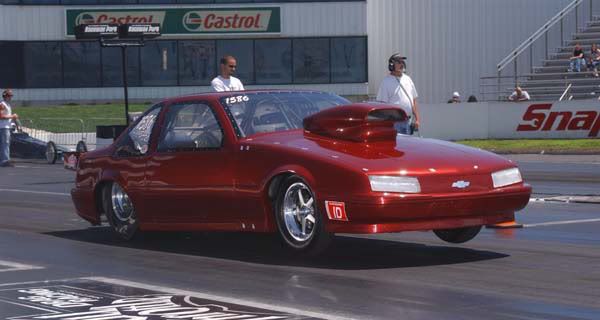Mike Peters wrote:The laws of physics cannot be denied.
Very true. But, they must be properly applied.
With an analysis of this sort, it is important to satisfy the physical constraints for the overall system before considering the internal forces and moments. To illustrate the absurdities that can cloud an analysis, we cannot consider the forces involved as the driver chews gum. Similarly, ring and pinion forces need not be considered.
So, we'll step back and consider first the entire car. Before the engine is started, the car is statically stable. It follows, therefore, that we need concern ourselves only with those dynamic forces which arise as a result of the launch. These forces and moments can act on the car only at those points and surfaces where the car comes into contact with the outside world. For the entire car, this would be the two tire patches. (It's actually four, of course, but we're going to be considering the car in side view, so I'll combine the two patches at each end.) At the rear tire patch, a forward force is acting to accelerate the car forward. The reaction to this acceleration is a horizontal inertial force, acting toward the rear at the center of gravity. These two forces, though equal in magnitude, are acting at different heights and, therefore, creating a moment (torque) on the car. This moment must be balanced (canceled), so vertical forces appear at the front and rear tire patches. This vertical force is, of course, the weight transfer.
So, if we know the car weight, acceleration, CG height, and wheelbase, we can calculate the weight transfer. Note that this is accomplished without knowledge of 4link spread, axle ratio, IC location, etc. These are all internal matters and do not affect an analysis of the entire car. (Yes, I realize the rise of the front of the car can affect CG height.)
This analysis of the entire car is called a "free body" analysis. In other words, the "body" is separated from its surrounding and forces and moments are substituted to replace the effects of the surroundings.
The next step is to consider a "body" which consists of the entire rear axle assembly. Again, a force and moment balance must exist. With a ladder bar car, the "surroundings" act at the tire patch and the front pivot. The rear axle assembly can then be considered as merely a giant link, with pivots at the tire patch and at the front pivot. A moment cannot be generated at either of these two points, so the line of action of any force acting at one of the two pivots must pass through the other pivot.
So, what force is acting at the tire patch? Well, it must be a combination of the horizontal force pushing the car forward and the weight transfer. But, is all the weight transfer going to be a part of the force which has a line of action that passes through the front pivot? No, not necessarily. If that line passing through the tire patch and the front pivot is coincident with the 100% antisquat line, the force will include ALL the weight transfer. If it is at any other angle, some of the weight transfer is being carried through the suspension springs.
In any event, that force carried through the springs is balanced by an upward vertical force at the tire patch. The remaining vertical force, when combined with the horizontal force, is balanced with the forces acting on a line through the pivots.
But, this has been a ladder bar car and not a 4link. The instant center of a 4link, however, acts in exactly the same manner as the pivot of a ladder bar car.
Next, consider a "body" which consists of the entire car LESS the rear axle assembly. The only contacts with the surroundings are the front tire patch and the front pivot of a ladder bar car OR the instant center of a 4link car. Do not ascribe intelligence to inanimate matter. The body under consideration has no "idea" of 4link spread, bottom link angle, or anything other than the force it "feels" acting at the instant center.
Remember that a force can be moved anywhere along its line of action. You can balance a pencil on your finger or you can tie a string around its balance point and suspend it. Same force and same result. Only the point of application has been changed.
Similarly, that force acting at the instant center can be moved anywhere along its line of action. Remember, now, that "line of action" is the same as a line of constant percent antisquat.
It follows, then, that the percent antisquat is the defining factor in the determination of a car's dynamic performance during launch.
Roll steer effects occur when, as a result of chassis roll, the entire rear axle assembly rotates in plan view, causing a steering effect akin to the push karts you might have built as a boy. Anecdotal consequences, such as have been supplied, emphasize the importance of the elimination of that chassis roll which occurs as a result of driveshaft torque. An ARB helps, but complete elimination of chassis roll can only be achieved with some form of suspension asymmetry which cancels the driveshaft torque effect.
http://www.racetec.cc/shope/tim.44.htm